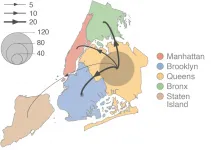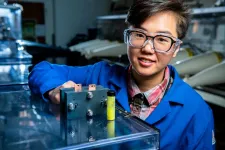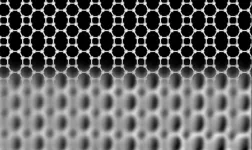(Press-News.org) Researchers have long been interested in finding ways to use simple hydrocarbons, chemicals made of a small number of carbon and hydrogen atoms, to create value-added chemicals, ones used in fuels, plastics, and other complex materials. Methane, a major component of natural gas, is one such chemical that scientists would like to find to ways to use more effectively, since there is currently no environmentally friendly and large-scale way to utilize this potent greenhouse gas.
A new paper in Science provides an updated understanding of how to add functional groups onto simple hydrocarbons like methane. Conducted by graduate students Qiaomu Yang and Yusen Qiao, postdoc Yu Heng Wang, and led by professors Patrick J. Walsh and Eric J. Schelter, this new and highly detailed mechanism is a crucial step towards designing the next generation of catalysts and finding scalable approaches for turning greenhouse gases into value-added chemicals.
In 2018, a paper published in Science described a mechanism for adding functional groups onto methane, ethane, and other hydrocarbons at room temperature using a cerium-based photocatalyst. The ability to use earth-abundant metals like cerium to create value-added chemicals was an exciting prospect, the researchers say. However, there were aspects of this study that Schelter and his group, who have been working with cerium for a number of years, wanted to understand more thoroughly.
"There were some things in the original paper that we thought were interesting, but we didn't necessarily agree with the conclusions based on the data that they were reporting," Schelter says. "We had an idea that what was happening in terms of the mechanism of the reaction, the steps that were involved and the catalyst that was operative for their chemistry, was different from what they were reporting."
To run the experiments and collect the data they would need to support a new hypothesis, Schelter and Walsh applied for a seed grant from the University of Pennsylvania's Vagelos Institute for Energy Science and Technology. This funding supported a new collaboration between Schelter and Walsh, allowing the researchers to purchase specialized equipment and hire Yu Heng Wang, a former Penn postdoc who is now an assistant professor at National Tsinghua University in Taiwan.
Thanks to the Vagelos Institute support, the Schelter and Walsh groups were able to combine their complementary expertise in inorganic and organic chemistry and to conduct experiments to obtain data required to propose a new mechanism. This included synthesizing new chemicals, studying reaction rates, looking at how the photocatalyst reacted with different isotopes, and computational analysis. The researchers also isolated the proposed reaction intermediate and were able to obtain its crystal structure, an additional challenge considering that many of the compounds in this study were highly air- and moisture-sensitive.
"We are using conventional techniques to understand the system better and to give a clear mechanism," Yang says about their approach. "Here, we are mostly using the inorganic perspective with different techniques to understand the mechanisms of the organic reaction. So, it's a collaboration of inorganic and organic perspectives to understand the mechanism."
After more than two years of work, the researchers were able to propose a revised mechanism that highlights the essential role of chlorine atoms. While the previous study implicated an alcohol-based intermediate, this latest study found that chlorine radicals, atoms with unpaired electrons that make them highly reactive, form a selective chemical "trap" in the photocatalyst that can give rise to different products.
"I think the hardest part was to understand why the reactivity was happening, and we had to approach that with some unconventional thinking of these intermediate complexes," says Walsh. "The behavior of the intermediates fits a pattern that people attribute to a radical based on oxygen, but in fact it's really a chlorine radical that's the active species, activating the alcohol to make it look like it's a radical derived from the alcohol."
Having a detailed understanding of this chemical reaction is a crucial step towards improving existing catalysts and making these and other chemical reactions more efficient. "In order to rationally develop the next generation of catalysts, we have to understand what the current generation is doing," says Walsh. "With this information, we and others can now build on this revised mechanism and reaction pathway to push the science forward."
And while there is more work to be done towards finding a fast, scalable reaction for methane transformation, having a detailed understanding of the mechanisms that drive this specific reaction is essential to both reducing greenhouse gas emissions and being able to use methane to create value-added products, the researchers say.
"Chemistry is at its most elegant when we can refine knowledge through expanded insight," says Schelter. "The contribution here is about getting the right model and using it to advance to the next generation of catalysts that will be even better than the current one."
INFORMATION:
This research was supported by Penn's Vagelos Institute for Energy Science and Technology, the Center for Actinide Science and Technology, an Energy Frontier Research Center funded by the U.S. Department of Energy (Grant DE-SC0016568), and the National Science Foundation (Grant CHE-1902509).
HOUSTON - (May 20, 2021) - It's always good when your hard work reflects well on you.
With the discovery of the giant polarization rotation of light, that is literally so.
The ultrathin, highly aligned carbon nanotube films first made by Rice University physicist Junichiro Kono and his students a few years ago turned out to have a surprising phenomenon waiting within: an ability to make highly capable terahertz polarization rotation possible.
This rotation doesn't mean the films are spinning. It does mean that polarized light from a laser or other source can now be manipulated in ways that were previously out of reach, making it completely visible or completely opaque with a device that's extremely ...
At the start of the COVID-19 outbreak, a University of Illinois Chicago researcher conducted a survey asking respondents if they experienced health care delays because of the pandemic. In addition to learning about the types of delays, the study also presented a unique opportunity to capture a historic moment at the pandemic's beginning.
Elizabeth Papautsky, UIC assistant professor of biomedical and health information sciences, is first author on "Characterizing Healthcare Delays and Interruptions in the U.S. During the COVID-19 Pandemic Using Data from an Internet-Based Cross-Sectional ...
During the first phase of the COVID-19 epidemic, New York City experienced high prevalence compared to other U.S. cities, yet little is known about the circulation of SARS-CoV-2 within and among its boroughs. A study published in PLOS Pathogens by Simon Dellicour at Université Libre de Bruxelles, Belgium, Ralf Duerr and Adriana Heguy at New York University, USA, and colleagues describe the dispersal dynamics of COVID-19 viral lineages at the state and city levels, illustrating the relatively important role of the borough of Queens as a SARS-CoV-2 transmission hub.
To better understand how the virus dispersed throughout New York ...
Ancient pollen samples and a new statistical approach may shed light on the global rate of change of vegetation and eventually on how much climate change and humans have played a part in altering landscapes, according to an international team of researchers.
"We know that climate and people interact with natural ecosystems and change them," said Sarah Ivory, assistant professor of geosciences and associate in the Earth and Environmental Systems Institute, Penn State. "Typically, we go to some particular location and study this by teasing apart these influences. In particular, we know that the impact people have goes back much earlier than what is typically ...
A compound used widely in candles offers promise for a much more modern energy challenge--storing massive amounts of energy to be fed into the electric grid as the need arises.
Scientists at the U.S. Department of Energy's Pacific Northwest National Laboratory have shown that low-cost organic compounds hold promise for storing grid energy. Common fluorenone, a bright yellow powder, was at first a reluctant participant, but with enough chemical persuasion has proven to be a potent partner for energy storage in flow battery systems, large systems that store energy for the grid.
Development of such storage is critical. When the grid goes offline due to severe weather, for instance, the large batteries under ...
Wherever ecologists look, from tropical forests to tundra, ecosystems are being transformed by human land use and climate change. A hallmark of human impacts is that the rates of change in ecosystems are accelerating worldwide.
Surprisingly, a new study, published today in Science, found that these rates of ecological change began to speed up many thousands of years ago. "What we see today is just the tip of the iceberg" noted co-lead author Ondrej Mottl from the University of Bergen (UiB). "The accelerations we see during the industrial revolution and modern periods have a deep-rooted history stretching back in time."
Using a global network of over 1,000 fossil pollen records, the team found - and expected to find - a first peak ...
Carbon exists in various forms. In addition to diamond and graphite, there are recently discovered forms with astonishing properties. For example graphene, with a thickness of just one atomic layer, is the thinnest known material, and its unusual properties make it an extremely exciting candidate for applications like future electronics and high-tech engineering. In graphene, each carbon atom is linked to three neighbours, forming hexagons arranged in a honeycomb network. Theoretical studies have shown that carbon atoms can also arrange in other flat network patterns, while still binding to three neighbours, but none of these predicted networks had been realized until now.
Researchers at the University of Marburg ...
Analyzing data obtained with the Atacama Large Millimeter/submillimeter Array (ALMA), researchers found a galaxy with a spiral morphology by only 1.4 billion years after the Big Bang. This is the most ancient galaxy of its kind ever observed. The discovery of a galaxy with a spiral structure at such an early stage is an important clue to solving the classic questions of astronomy: "How and when did spiral galaxies form?"
"I was excited because I had never seen such clear evidence of a rotating disk, spiral structure, and centralized mass structure in a distant galaxy in any previous ...
A new study published in the journal Science, highlights the opportunity to complement current climate mitigation scenarios with scenarios that capture the interdependence among investors' perception of future climate risk, the credibility of climate policies, and the allocation of investments across low- and high-carbon assets in the economy.
Climate mitigation scenarios are key to understanding the transition to a low-carbon economy and inform climate policies. These scenarios are also important for financial investors to assess the risk of missing out on the transition or making the transition happen too late and in a disorderly fashion. In this respect, the scenarios developed by the platform of financial authorities ...
Deaths caused by indirect effects of the pandemic emphasize the need for policy changes that address widening health and racial inequities.
More than 15 months into the pandemic, the U.S. death toll from COVID-19 is nearing 600,000. But COVID-19 deaths may be underestimated by 20%, according to a new, first-of-its-kind study from Boston University School of Public Health (BUSPH), the University of Pennsylvania, and the Robert Wood Johnson Foundation.
Published in the journal PLOS Medicine, the study uses data from the National Center for Health Statistics (NCHS) and the Centers for Disease Control and Prevention ...






